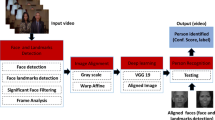Abstract
This paper proposes a novel video face identification method, named “3D-2D-DCNN cascade” that serially combines 3D and 2D deep convolutional neural networks (DCNNs) for robust video face recognition (FR). In our method, an input video (face) sequence is first divided into a number of sub-video sequences and each of the sub-video sequences is then used as an input to the 3D-DCNN, aiming to obtain a set of class-confidence scores for a given input video sequence. These class-confidence scores are aggregated in a novel way, resulting in the formation of our novel class-confidence matrix. Key characteristic of our method is to make use of this class-confidence matrix for fine-tuning 2D-DCNN, which is serially linked to 3D-DCNN, to obtain the final face identification results. To verify the proposed method, two popular video identification benchmarks, COX Face and YTC databases, were used. Compared to the best reported recognition results on these two benchmarks, our proposed method achieves better or comparable recognition performances.





Similar content being viewed by others
References
Deng J, et al (2018) Arcface: additive angular margin loss for deep face recognition. In: arXiv preprint arXiv:1801.07698
Ding C, Tao D (2018) Trunk-branch ensemble convolutional neural networks for video-based face recognition. IEEE Trans Pattern Anal Mach Intell 40(4):1002–1014
Glorot X, Bengio Y (2010) International conference on artificial intelligence and statistics. In: Understanding the difficulty of training deep feedforward neural networks, pp 249–256
Gong S, Yichun S, Jain AK (2019) Video face recognition: component-wise feature aggregation network (C-FAN). arXiv preprint arXiv:1902.07327
Goyal P, et al (2017) Accurate, large minibatch SGD: training imagenet in 1 hour. arXiv:1706.02677
GU J, et al (2018) Recent advances in convolutional neural networks. Pattern Recogn 77:354–377
Hayat M, Bennamoun M, An S (2015) Deep reconstruction models for image set classification. IEEE Trans Pattern Anal Mach Intell 37(4):713–727
Hernández-Durán M, Plasencia-Calaña Y, Méndez-Vázquez H (2018) Low-resolution face recognition with deep convolutional features in the dissimilarity space. International Workshop on Artificial Intelligence and Pattern Recognition, pp 95–103
Huang Z, Wang R, Shan S, Chen X (2014) Learning euclidean-to-riemannian metric for point-to-set classification. In Proceedings of the IEEE Conference on Computer Vision and Pattern Recognition:1677–1684
Huang Z, Shan S, Wang R, Zhang H, Lao S, Kuerban A, Chen X (2015) A benchmark and comparative study of video-based face recognition on cox face database. IEEE Trans Image Process 24(12):5967–5981
Huang Z, Wang R, Shan S, Chen X (2015) Projection metric learning on Grassmann manifold with application to video based face recognition. Proc IEEE Conf Comput Vis Pattern Recognit:140–149
Intra-Face (2013) http://humansensing.cs.cmu.edu/intraface. Accessed June, 23, 2017
Jia X, et al (2018) Highly scalable deep learning training system with mixed-precision: training imagenet in four minutes. In: arXiv:1807.11205
Karpathy A, et al (2014) Large-scale video classification with convolutional neural networks. Proc IEEE Conf Comput Vis Pattern Recognit:1725–1732
Keskar NS, et al (2017) On large-batch training for deep learning: generalization gap and sharp minima. In: arXiv:1609.04836
Kim M, Kumar S, Pavlovic V, Rowley H (2008) Face tracking and recognition with visual constraints in real-world videos. In IEEE Conf Computer Vision and Pattern Recognition:1–8
Liao X, Li K, Zhu X, Liu KR (2020) Robust detection of image operator chain with two-stream convolutional neural network. IEEE Journal of Selected Topics in Signal Processing:1–1
Lu J, Wang G, Deng W, Moulin P, Zhou J (2015) Multimanifold deep metric learning for image set classification. Proc IEEE Conf Comput Vis Pattern Recognit:1137–1145
Lu J, Wang G, Moulin P (2016) Localized multifeature metric learning for image-set-based face recognition. IEEE Transactions on Circuits and Systems for Video Technology 26(3):529–540
Masters D, Luschi C (2018) Revisiting small batch training for deep neural networks. arXiv:1804.07612
Parchami M, Bashbaghi S, Granger E (2017) Cnns with cross-correlation matching for face recognition in video surveillance using a single training sample per person. 2017 14th IEEE International Conference on Advanced Video and Signal Based Surveillance (AVSS), pp 1–6
Parchami M, Bashbaghi S, Granger E (2017) Video-based face recognition using ensemble of haar-like deep convolutional neural networks. IJCNN
Parkhi OM, Vedaldi A, Zisserman A (2015) Deep face recognition. European Conference on Computer Vision, pp 1–12
Qi X, Liu C, Schuckers S (2018) Boosting face in video recognition via cnn based key frame extraction. 2018 International Conference on Biometrics (ICB), pp 132–139
Rao Y, Lu J, Zhou J (2019) Learning discriminative aggregation network for video-based face recognition and person re-identification. Int J Comput Vis 127(6–7):701–718
Tran D, et al (2015) Learning spatiotemporal features with 3d convolutional networks. Proceedings of the IEEE International Conference on Computer Vision:4489–4497
Wang R, Chen X (2009) Manifold discriminant analysis. In CVPR, pp:429–436
Wang H, Wang Y, Cao Y (2009) Video-based face recognition: a survey. World Academy of Science, Eng Technol 60:293–302
Wu Y, He K (2018) Group normalization. Proceedings of the European conference on computer vision (ECCV), pp 3–19
Yang M, Wang X, Liu W, Shen L (2016) Joint regularized nearest points for image set based face recognition. Image Vis Comput 58:47–60
Yang J, Ren P, Zhang D, Chen D, Wen F, Li H, Hua G (2017) Neural aggregation network for video face recognition. IEEE Conference on Computer Vision and Pattern Recognition 4(6):7
Funding
This research was supported by Hankuk University of Foreign Studies Research Fund. This research was supported by Basic Science Research Program through the National Research Foundation of Korea (NRF) funded by the Ministry of Education under Grant 2018R1D1A1A09082615.
Author information
Authors and Affiliations
Corresponding author
Additional information
Publisher’s note
Springer Nature remains neutral with regard to jurisdictional claims in published maps and institutional affiliations.
Rights and permissions
About this article
Cite this article
Kim, K.T., Lee, B. & Choi, J.Y. 3D-2D deep convolutional neural network (DCNN) Cascade for robust video face identification. Multimed Tools Appl 80, 4023–4036 (2021). https://doi.org/10.1007/s11042-020-09495-0
Received:
Revised:
Accepted:
Published:
Issue Date:
DOI: https://doi.org/10.1007/s11042-020-09495-0




